In real estate, first impressions and fast follow up close deals. Buyers and sellers now expect mobile first, contactless interactions that make it effortless to connect and stay in touch. A quick tap, a scan, or a single link should instantly provide your contact details, property information, and a clear path to book a call.
The problem, paper business cards get lost, details go out of date, and manual data entry into your CRM slows you down. That delay costs leads and undermines brand consistency across teams. It also creates operational headaches for brokerages that need standardised profiles and secure provisioning.
This guide shows why smart business cards are essential in 2025, and how Tapt helps agents and brokerages capture every lead, automate follow up, and manage profiles at scale. From open houses to listing presentations, you will see how tap to share interactions translate into faster conversations, cleaner data, and stronger branding.
Your next listing lead expects instant, mobile first interaction, often before they have left the driveway.
Key Takeaways
- NFC and QR, no app required, make sharing contact details and property info instant, and with the NFC market growing at 17.6% annually according to Grand View Research, clients increasingly expect tap to connect moments.
- Mobile first buyers want frictionless access on their phones, and with 76% of home buyers using a mobile device to search for homes, as reported by the National Association of Realtors, digital cards meet people where they already are.
- Speed to lead wins, research from InsideSales.com and Harvard Business Review shows contacting leads within five minutes can make you up to nine times more likely to convert compared to 30 minutes, which is why automated follow up from a tap matters.
- Going digital reduces waste and reprint costs, and with Adobe noting that 88% of paper cards are thrown away within a week, smart cards offer sustainability and ROI in one move.
- Brokerages can standardise branding and security with central admin controls, SSO, and directory integrations, aligning with an industry wide push as the proptech market scales towards $86.5 billion by 2032, according to MarketsandMarkets.
What Smart Business Cards Are, and How They Work for Agents
Smart business cards are digital profiles that share your details via NFC and QR, no app required. A prospect taps your card with their phone or scans a code, and your dynamic profile opens instantly. That profile can include a save to contact button, click to call, links to current listings, a calendar booking link, and your social channels. You can also embed a short lead form so people who want more info can register in seconds.
It feels simple to the client, which is the point. The technology behind the scenes is reliable and mainstream. The NFC market was valued at USD 24.05 billion in 2023 and is growing at 17.6% annually through 2030, as reported by Grand View Research, which means tap to share interactions are no longer novelty, they are normal.
For agents, the real advantage is flexibility. Update your phone number, add a new listing, tweak your booking calendar, or refresh your headshot, and those changes appear instantly on every future tap or scan. No reprints. No wasted stock. Given that Adobe estimates 88% of paper business cards are thrown away within a week, and companies waste around a billion dollars on them each year, switching to dynamic digital cards is a pragmatic, sustainable upgrade.
Here is what a modern agent’s smart profile typically includes:
- Save to contact, so your details land directly in their phone
- Click to call and click to email, with the right number and signature every time
- Property links, brochures, and video tours, tailored to the buyer or listing
- Calendar booking for appraisals and buyer consults
- Lead capture form with privacy consent, so you collect clean data
- Social profiles and testimonials for instant credibility
You can carry your physical NFC card, add your QR code to yard signs and brochures, and embed your profile link in your email signature and link in bio. This meets buyers where they are. With the National Association of Realtors reporting that 76% of buyers use mobile devices to search for homes, creating one easy mobile entry point for everything you offer simply makes sense.
For example, at an open house, a buyer taps your card, saves your contact, and gets a curated property pack on the spot. They can register interest, opt in to updates, and book a follow up, all from one link. That single interaction can kick off the next phase of your relationship.
Why 2025 Is the Tipping Point for Real Estate Networking
Consumer behaviour has shifted. Buyers expect instant access to relevant information and a frictionless way to save your details. They do not want to type in phone numbers, and they rarely keep slips of paper. They want fast, contactless interactions that lead somewhere useful, like a property tour or a calendar invite. With most buyers already on their phones during the journey to purchase, as the NAR mobile figure shows, the opportunity to make a strong first connection is sitting right there.
Speed to lead is just as important. When a buyer scans your QR at a yard sign or taps your card at an open home, the clock starts. Research from InsideSales.com and Harvard Business Review found that contacting a lead within five minutes can make you up to nine times more likely to convert compared to waiting 30 minutes. In other words, automated follow up from a tap is not just a nice to have, it is a revenue driver.
Brand and sustainability now matter more in presentation heavy industries like real estate. Digital first branding signals you are current and considerate. It also removes reprint costs and waste. With Adobe highlighting how quickly paper cards are discarded, and CGS reporting that 88% of consumers prefer companies that help them be more environmentally friendly, smart cards give you a clear positioning edge during listing presentations.
Privacy awareness is rising too. People want to know what they are opting into and that their data is handled properly. Pew Research Center has noted that many consumers feel the risks of data collection can outweigh the benefits, which makes consent based, transparent lead capture essential for trust and data quality. Clear language, easy opt ins, and a simple link to your privacy policy all help.
Put together, 2025 is not just another year to try a digital card. It is the moment to embed contactless, data driven networking across your workflow, from open homes to appraisals to everyday introductions.
Capture Every Lead and Sync to Your CRM Automatically
Real estate is a fast moving, high touch business. The agents who win do two things well, they make it effortless to connect, and they follow up fast. Smart business cards take care of both. Every tap or scan can open your profile, collect the visitor’s details with consent, and route that information to your CRM and marketing tools in seconds.
At an open house, a simple check in flow sets the tone. Greet visitors and ask them to tap your card or scan the QR by the door. Your profile opens with a quick form, name, email, phone, and a consent box. Once submitted, the buyer receives an instant property pack, photos, floor plan, disclosures, and your calendar link. You get a clean lead created in your CRM with the source, the property they visited, and the time of the tap.
This automation is not just convenient, it is commercially important. The InsideSales.com and HBR lead response data shows that the first five minutes matter. If your card automatically sends a welcome SMS or email, assigns a follow up task, and tags the lead to your pipeline, you are operating at the speed the buyer expects.
It is also part of a broader digital shift in the sector. The proptech market is projected to grow rapidly over the next decade, with MarketsandMarkets forecasting significant expansion as agencies digitise client engagement. Smart cards are a practical, high impact entrance to this transformation because they connect the offline moment to your online systems with almost no friction.
To make the most of this, ensure your cards and profiles are connected to the rest of your stack. With Tapt, teams can integrate with popular CRMs and workflows through integrations, route leads based on office or territory, and trigger automation that fits your process. You can also track performance by agent, office, or event, using UTM links to see which channels and scripts convert best.
Example lead flow
- A buyer scans the QR on your yard sign and opens your profile
- They submit a short form to receive the brochure, with privacy consent
- Their details sync straight to your CRM with the property as the source
- An automated text thanks them and offers a calendar link for a private viewing
- Your dashboard logs the tap and conversion, ready for follow up and reporting
This is how you turn conversations into audited, trackable leads without spreadsheets or manual entry. It is also how you shorten the gap between interest and action, which is often where deals are won.
Scale Across Your Brokerage with Centralised Control
For broker owners and operations leaders, the real challenge is scale. You need consistent, compliant profiles across offices, efficient provisioning for new starters, and a secure way to revoke access when people move on. You also need brand control that respects local customisation, so agents can showcase their area and specialisation without breaking templates.
Tapt helps teams run smart cards like a modern software rollout, not a print job. With single sign on and directory integrations, you can provision and deprovision agents fast, keep permissions tidy, and align access with your identity policies. Central admin tools let you lock brand elements, colours, fonts, disclaimers, and approved links, while still allowing agents to update headshots, bios, and personal contact details.
Bulk management is where time is saved. Need to update an office phone number, add a new compliance disclosure, or link to a seasonal campaign, you can apply those changes across all profiles in minutes. You can also audit usage, monitor tap rates by team, and ensure every agent’s profile is live and accurate.
If you are standardising digital cards for a team, explore the Tapt Teams and Admin features to see how centralised controls and permissions work in practice. This gives you the governance you need without slowing your agents in the field.
Example, new agents can receive a branded profile and NFC card on day one, loaded with the right links and disclosures. If someone changes teams, access can be revoked promptly, ensuring your data stays secure and your branding remains consistent across the network.
Best Practice Playbook, Scripts and Use Cases that Win
Smart cards are only as good as the moments you create with them. The best agents weave them into their greetings, tours, and follow ups, so tapping the card becomes the natural next step in the conversation. Here are practical plays you can use this weekend.
Open house flow, set the tone early
- Greet at the door, then say, “Before we tour, tap here to save my contact and get the full property pack, photos, floor plan, and disclosures.”
- Use a short form with consent so you capture names and contact details accurately
- Auto send the brochure and your calendar link so booking a private viewing is one tap
- Place a QR code at the entrance and kitchen island as a backup for non NFC phones
Listing presentations, showcase your proof fast
- Share a one tap portfolio link, recent sales, testimonials, and a concise market snapshot
- Include a digital pre list pack with checklists and staging tips to demonstrate value
- Offer a booking link that fits the vendor’s calendar, not yours
Yard signs and print, capture drive by interest 24,7
- Add QR and NFC tags to signs, price flyers, and window cards
- Use property specific profiles so taps sync to the right pipeline with the right source
- Trigger an instant message with the brochure and a prompt to book a private viewing
Digital touchpoints, be discoverable everywhere
- Put your smart card link in your email signature and your link in bio
- Add QR codes to postcards and door knockers for a quick digital handoff
- Ensure your profile is mobile optimised, with clear call to action buttons and a short intro
Follow up, move from introduction to appointment
- Send an instant thank you with your calendar and a shortlist of relevant properties
- Use templates that trigger based on the property or event to save time
- Within five minutes is the goal, the InsideSales.com and HBR data shows how conversion rates spike when you respond quickly
These plays are simple, but they compound. When every tap routes to the right place, your database grows cleanly, your follow up happens promptly, and your brand shows up consistently in every interaction. If you are just getting started, this article pairs well with our overview of benefits in NFC business card advantages.
Capture Insights, Optimise Scripts, and Improve Speed to Lead
The advantage of a digital first approach is the data you get back. A good platform tracks taps, scans, and conversions by agent, property, and event. You can see which open houses drew the most check ins, which scripts yielded higher form completion, and which channels drove drive by enquiries.
Use this to run simple experiments. Test the phrasing at the front door, try a shorter form, or move the QR placement. Because the profile is dynamic, you can iterate quickly without reprinting a thing. In other words, you are constantly tuning your first impression and your follow up without any extra operational drag.
This kind of feedback loop is how teams lift speed to lead and lead quality at the same time. It is also how brokerages coach at scale, using real data to identify best practice across offices.
How to Choose the Right Smart Card Platform
There are many vendors in the market. To avoid lock in and ensure your team gets real value, evaluate platforms against your full workflow, not just the card itself. Here is a clear checklist you can use in vendor reviews.
- Dynamic profiles with real time editing, rich actions like save contact, book a meeting, and message, and property friendly layouts
- Strong integrations with SSO and directories, plus CRM and marketing tools, ideally with access to 5,000 plus business apps via connectors, explore Tapt’s integrations
- Security, permissions, audit logs, and data residency options that align with your compliance requirements
- Analytics that show taps, scans, form completions, and team performance, with UTM support for campaigns
- Durable NFC materials, custom branding, and responsive support for teams
Look at ROI the same way you would any listing investment. One additional closed transaction can offset the platform cost many times over. When you consider the removal of reprint costs and the waste of paper cards that Adobe highlights, the financial case becomes even clearer. On top of that, the macro signals point one way, with the NFC market growing strongly, as Grand View Research notes, and proptech spending expanding, as MarketsandMarkets outlines.
If you are evaluating solutions now, start with Tapt’s real estate solution page, then schedule a walkthrough to see admin controls and automation in action. You can explore features for teams at Teams and Admin, review integrations, and compare pricing options that fit the size of your agency.
Why Tapt for Real Estate Teams
Tapt. is built to help agents connect faster and help brokerages scale with confidence. You get dynamic profiles that adapt to how you sell, not the other way around. You get centralised controls that keep your brand consistent and your security tight. You get the integrations and analytics you need to make smarter decisions across the whole client journey.
For real estate specifically, the Tapt real estate solution focuses on the moments that matter, open houses, listing presentations, yard sign enquiries, and day to day networking. Your agents can set up once, then use their card everywhere, in person and online, while ops manages everything centrally. It is a simple, high impact way to modernise networking without changing the heart of what you do, build trust in person.
Conclusion
Smart business cards turn real world conversations into digital connections you can track, automate, and scale. Agents gain speed to lead, cleaner data, and stronger branding, with no reprints and no manual entry. Buyers and vendors get the easy, mobile first experiences they expect, and a clear, consistent impression of your brand.
In 2025, winning brokerages will blend in person trust with contactless, data driven workflows. Tapt brings it together with dynamic profiles, centralised admin controls, SSO and directory support, and deep integrations with the tools you already use. It is a practical path to a more modern, more measurable approach to networking.
See it in action, book a demo with our team, order branded NFC cards for your team, or create a free profile via the Tapt app.


Sustainability Report